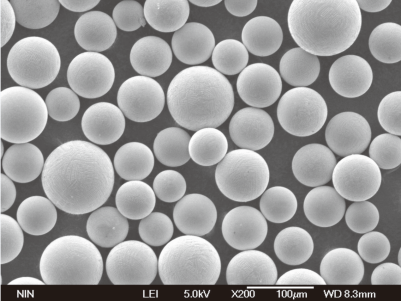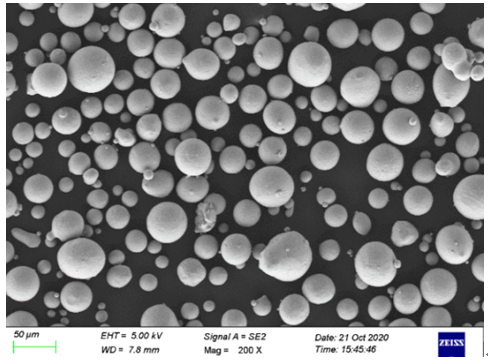Poudre de CuAlNiun alliage unique composé de cuivre (Cu), d'aluminium (Al) et de nickel (Ni), est largement reconnu pour ses propriétés mécaniques impressionnantes, son effet de mémoire de forme et sa résistance à la corrosion. Ce matériau polyvalent a trouvé des applications dans des industries allant de l'aérospatiale au biomédical. Dans ce guide détaillé, nous explorerons la composition, les caractéristiques, les utilisations, les avantages et les limites de la poudre CuAlNi. Nous présentons également des modèles de poudres métalliques spécifiques, des spécifications détaillées et une section FAQ complète pour répondre aux questions les plus courantes.
Aperçu de la poudre de CuAlNi
La poudre CuAlNi est une poudre d'alliage à base de cuivre qui tire parti de la synergie unique de ses composants pour produire un matériau aux propriétés exceptionnelles. Connue pour ses attributs de haute performance, cette poudre est particulièrement appréciée pour son effet de mémoire de forme, qui lui permet de reprendre sa forme initiale après déformation lorsqu'elle est exposée à des températures spécifiques.
Caractéristiques principales de la poudre de CuAlNi
- Composition: Principalement du cuivre avec des proportions soigneusement contrôlées d'aluminium et de nickel.
- Applications: Utilisé dans les actionneurs, les capteurs, les appareils biomédicaux, les composants aérospatiaux, etc.
- Propriétés: Excellente conductivité thermique et électrique, résistance à la corrosion et à l'usure.
- Forme: Généralement disponibles sous forme de poudres fines avec des tailles de particules uniformes pour des applications précises.

Types et modèles spécifiques de Poudre de CuAlNi
Voici un examen plus approfondi des modèles de poudres CuAlNi spécifiques, de leur composition et de leurs applications :
| Nom du modèle | Composition | Taille des particules | Applications |
|---|---|---|---|
| CuAlNi-10-20 | Cu (80%), Al (10%), Ni (10%) | 10-20 microns | Actionneurs et interrupteurs à mémoire de forme |
| CuAlNi-15-10 | Cu (75%), Al (15%), Ni (10%) | 15-25 microns | Composants aérospatiaux, pales de turbines |
| CuAlNi-20-15 | Cu (70%), Al (20%), Ni (10%) | 20-30 microns | Implants biomédicaux de précision |
| CuAlNi-12-12 | Cu (76%), Al (12%), Ni (12%) | 5-15 microns | Capteurs microélectroniques |
| CuAlNi-Fine30 | Cu (78%), Al (12%), Ni (10%) | <10 microns | Soudage et brasage de haute précision |
| CuAlNi grossier50 | Cu (75%), Al (15%), Ni (10%) | 30-50 microns | Composants structurels, roulements industriels |
| CuAlNi-Super20 | Cu (72%), Al (18%), Ni (10%) | 10-20 microns | Matériaux intelligents pour la robotique |
| CuAlNi-Nano | Cu (80%), Al (10%), Ni (10%) | <1 micron | Applications avancées des nanotechnologies |
| CuAlNi-BioMed | Cu (75%), Al (15%), Ni (10%) | 10-15 microns | Implants biocompatibles |
| CuAlNi-HighTemp | Cu (78%), Al (12%), Ni (10%) | 20-40 microns | Composants des fours à haute température |
Composition de la poudre de CuAlNi
La composition de la poudre de CuAlNi influence considérablement ses propriétés physiques et mécaniques. Voyons cela de plus près :
| Élément | Pourcentage (%) | Fonction |
|---|---|---|
| Cuivre (Cu) | 70-80 | Fournit la structure de base et la conductivité |
| Aluminium (Al) | 10-20 | Améliore la solidité et la résistance à la corrosion |
| Nickel (Ni) | 10-15 | Introduit les propriétés de mémoire de forme |
Variations
Les ratios spécifiques d'aluminium et de nickel sont ajustés en fonction des caractéristiques souhaitées, telles qu'une plus grande fonctionnalité de mémoire de forme ou une meilleure résistance aux conditions extrêmes.
Propriétés et caractéristiques de la poudre de CuAlNi
La poudre de CuAlNi est connue pour ses diverses propriétés, ce qui la rend adaptée à des applications exigeantes.
| Propriété | Description |
|---|---|
| Effet de mémoire de forme | Reprend sa forme initiale après déformation sous l'effet de la chaleur |
| Résistance à la corrosion | Performant dans les environnements difficiles, y compris dans les milieux marins |
| Conductivité thermique | Excellentes propriétés de transfert de chaleur |
| Conductivité électrique | Performance électrique efficace |
| Résistance mécanique | Résistance à la traction et durabilité élevées |
| Résistance à l'usure | Résistance supérieure à l'abrasion et à l'usure |
| Usinabilité | Facilement transformable et moulable en formes complexes |






Applications de la Poudre de CuAlNi
La poudre de CuAlNi est un matériau polyvalent qui trouve des applications dans de nombreuses industries.
| L'industrie | application | Avantages |
|---|---|---|
| Aérospatiale | Actionneurs, aubes de turbine | Léger, très résistant |
| Biomédical | Implants, outils chirurgicaux | Biocompatibilité, propriétés de mémoire de forme |
| Électronique | Capteurs, connecteurs | Conductivité élevée, performances précises |
| Automobile | Composants du moteur, engrenages | Résistance à l'usure, durabilité |
| Robotique | Matériaux intelligents pour les systèmes de mouvement | Effet de mémoire de forme, fiabilité |
| Marine | Composants résistants à la corrosion | Longue durée de vie en milieu salin |
Spécifications, tailles et normes
Le tableau ci-dessous résume les principales spécifications pour Poudres de CuAlNi:
| Spécifications | Détails |
|---|---|
| Gamme de taille des particules | Nano (<1 micron) à grossier (30-50 microns) |
| La pureté | 99.9% |
| Emballage | Sacs scellés, récipients sous vide |
| Normes | ISO 9001, ASTM B88 |
Fournisseurs et détails des prix
Voici quelques fournisseurs populaires et des prix indicatifs :
| Fournisseur | Région | Fourchette de prix (USD/kg) | Caractéristiques spéciales |
|---|---|---|---|
| Métaux PowderTech | Amérique du Nord | $80-120 | Taille des particules personnalisable |
| Solutions AlNi | L'Europe | $90-140 | Qualités biocompatibles disponibles |
| Poudres d'alliage mondiales | Asie | $70-100 | Remises sur les gros volumes |

Comparaison des avantages et des limites
| Aspect | Avantages | Limites |
|---|---|---|
| Coût | Abordable par rapport aux autres alliages | Légèrement supérieure à celle des poudres métalliques pures |
| Polyvalence | Large éventail d'applications | Offre limitée de qualités de niche |
| Effet de mémoire de forme | Propriété unique que l'on ne retrouve pas dans de nombreux matériaux | Nécessite un contrôle précis de la température |
FAQ
| Question | Réponse |
|---|---|
| À quoi sert la poudre de CuAlNi ? | Les applications comprennent les actionneurs, les capteurs, les implants et les turbines. |
| Comment fonctionne l'effet de mémoire de forme ? | Le matériau reprend sa forme initiale lorsqu'il est chauffé. |
| La poudre de CuAlNi est-elle chère ? | Les prix varient de $70-$140 par kg en fonction de la qualité et de la pureté. |
| CuAlNi peut-il être utilisé en milieu marin ? | Oui, sa résistance à la corrosion lui permet de s'adapter à ce type d'environnement. |
| Quelles sont ses principales propriétés ? | Résistance à la corrosion, solidité et caractéristiques de mémoire de forme. |

